Procyon is the brightest star in the constellation of Canis Minor, and usually the eight-brightest star in the night sky. It consists of two stars orbiting each other in a binary system.
Key Facts & Summary
- Procyon is a binary star system, consisting of the main star Procyon A – which is a white-hued main-sequence star of spectral type F5 IV-V, that is in orbit with a faint white dwarf companion of spectral type DQZ, named Procyon B.
- Procyon lies at a distance of just 11.45 light-years / 3.51 parsecs away from the Sun. It is one of Earth’s nearest stellar neighbors.
- This star culminates at midnight on the 14th of January.
- Bein the eight-brightest object in the night sky, Procyon has a visual magnitude of 0.34.
- Procyon B is much fainter, with a visual magnitude of 10.7.
- The star pair orbit each other within a period of 40.8 years and have an orbit eccentricity of 0.4 – more eccentric than even Mercury’s orbit.
- Together with Sirius and Betelgeuse, Procyon forms one of the three vertices of the Winter Triangle asterism. In the northern hemisphere, it is best viewed in late winter.
- Procyon A has an estimated 1.5 solar masses, while Procyon B is smaller than our sun – at 0.6 solar masses.
- Procyon is almost seven times brighter than our sun, having 6.93 solar luminosities. Its dim companion only has 0.00049 solar luminosity. Even the discovery of Procyon B was a big surprise due to its faintness.
- Procyon A is much older than its companion, at around 1.87 billion years while Procyon B is 1.37 billion years old.
- When it comes to temperature, Procyon A is hotter than our sun at around 6.530 K, while its companion Procyon B, is even hotter at around 7.740 K.
- Procyon A and B are around 8.9 AU away from each other, and sometimes they can get to even 21 AU. Their average separation is around 15 AU – almost the same distance from the Sun to Uranus.
Procyon, along with Sirius and Arcturus led to the discovery of proper motion. They shifted enough in the night sky since ancient times and English astronomer Edmond Halley pointed this in 1718. He compared his astrometric measurements to those given in Ptolemy’s Almagest – 2nd Century C.E – and thus concluded that the stars were not in fact “fixed.”
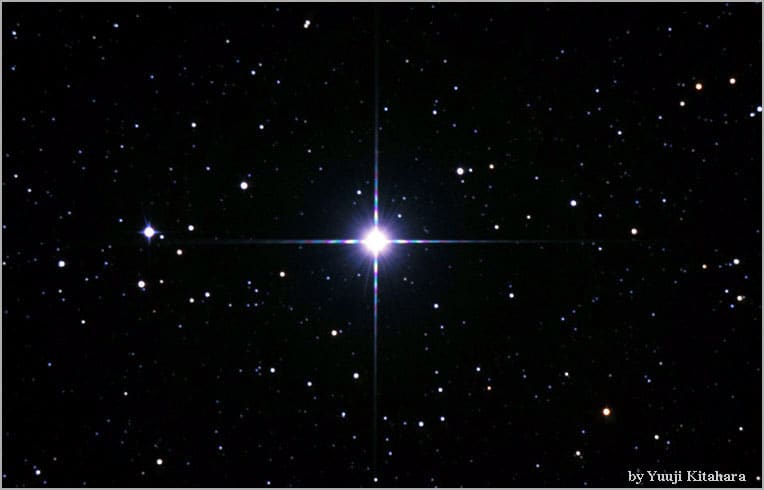
Procyon’s companion star – Procyon B – was speculated for a couple of years but only in 1896, it was visually confirmed. Astronomer J. M. Schaeberie used the world's largest refractor between 1888 to 1897 in order to confirm the star's existence.
The name Procyon was used by the ancient Greek astronomers as “Prokyon”, which the Romans translated into Latin as the equivalent – “Antecaris” – which translates to “Before the Dog”.
The reason it was named as such is that Procyon rises immediately after the brightest star in the night sky, Sirius. Sirius is named the Dog Star.
Procyon was also one of the fifteen Behenian fixed stars in medieval astrology. These stars were attributed with special powers, they were used in magic rituals. Procyon is usually considered a fortune star, portending fame and wealth and it was linked with the planets Mercury and Mars.
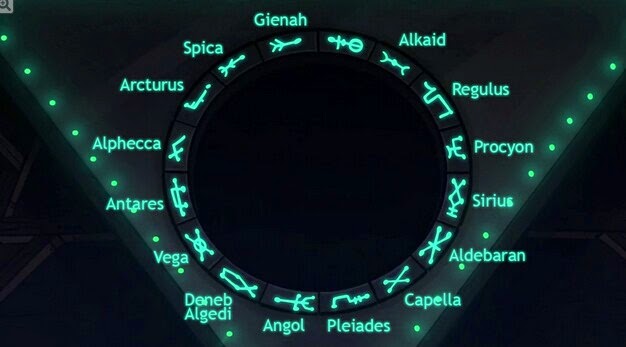
Formation
Procyon is an evolved star that is still on the main-sequence, appearing white in color. The star formed from a nebula of gas and dust. The swirling gas and dust were pulled by gravity in order to form what we today now see as the “Dog Follower” star. This happened around 1.87 billion years while Procyon B formed around 1.37 billion years ago.
Procyon B’s progenitor star most likely had around 2.59 solar masses. Estimates suggest that the star spent about 680 million years on the main-sequence, fusing hydrogen in its core. It evolved into a giant and lost much of its mass due to stellar winds. It ended its life cycle around 1.19 billion years ago when it became a white dwarf.
Distance, Size, and Mass
Procyon lies at a distance of just 11.45 light-years / 3.51 parsecs away from the Sun. It is one of Earth’s nearest stellar neighbors.
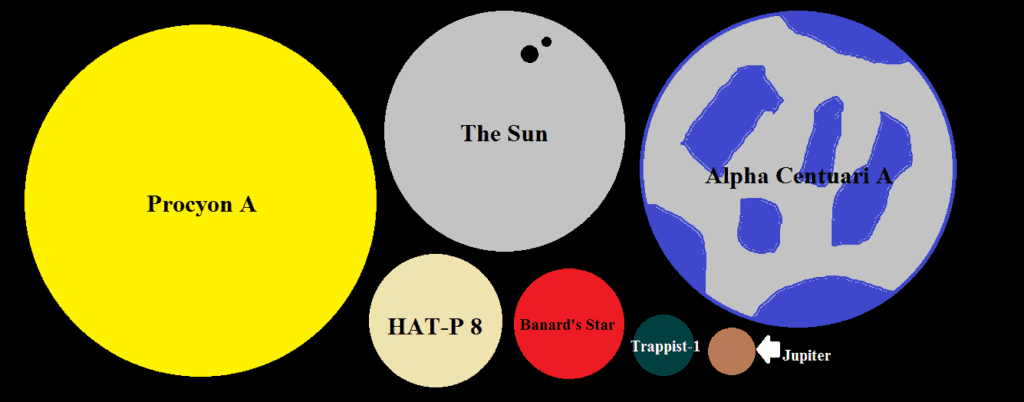
Procyon A has almost double the mass of the sun at an estimated 1.5 solar masses. Procyon B, on the other hand, is much smaller than our sun – at 0.6 solar masses.
As Procyon A will expand into the future, since it is evolving into a subgiant, it will eventually become way bigger. Procyon A has 2.04 the sun’s radius while its diameter is around four times bigger than our sun’s.
Other Characteristics
Procyon A is almost seven times brighter than our sun, with an apparent visual magnitude of 0.34 and the effective temperature of its stellar atmosphere is an estimated 6.530 K, hotter than our sun.
Its brightness is a little above its current spectral class – F5 IV-V - and thus it is an indicator that the star is evolving into a subgiant that has nearly fused its hydrogen core into helium.
After this process is completed, Procyon will begin to expand several times its current size. Procyon A completes one rotation upon its axis once every 23 days.
Stellar System
Procyon B is a white dwarf star, confirmed since 1896. It is considerably smaller than Procyon A, at around 0.6 solar masses – 60% of the sun’s mass.
It is much hotter than our sun, and even Procyon A – at an average surface temperature of around 7.750 K.
The mass of Procyon B’s progenitor has been estimated to have been around 2.59 solar masses and ended its life around 1.19 billion years ago.
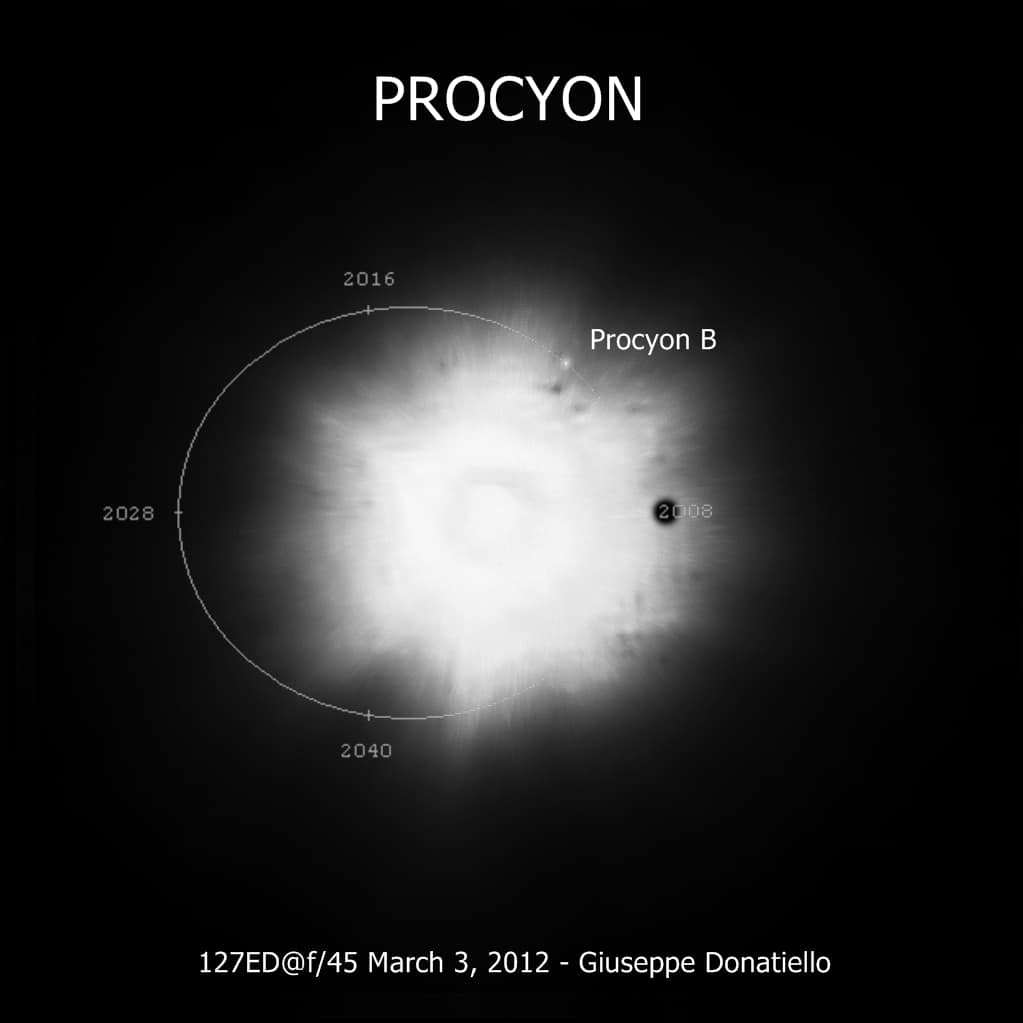
It has an estimated radius of around 8.600 km / 5.343 mi, and it has a helium-dominated atmosphere with traces of heavy elements. Its low mass is unusual for a white dwarf for reasons that are yet unclear.
The star pair orbit each other within a period of 40.8 years and have an orbit eccentricity of 0.4 – more eccentric than even Mercury’s orbit. Procyon A and B are around 8.9 AU away from each other, and sometimes they can get to even 21 AU. Their average separation is around 15 AU – almost the same distance from the Sun to Uranus.
Location
Procyon is the alpha star located in the constellation of Canis Minor – the small Dog. In mythology, Canis Minor is one of the smaller companions of Orion - the Hunter – who has two companion/hunting dogs.
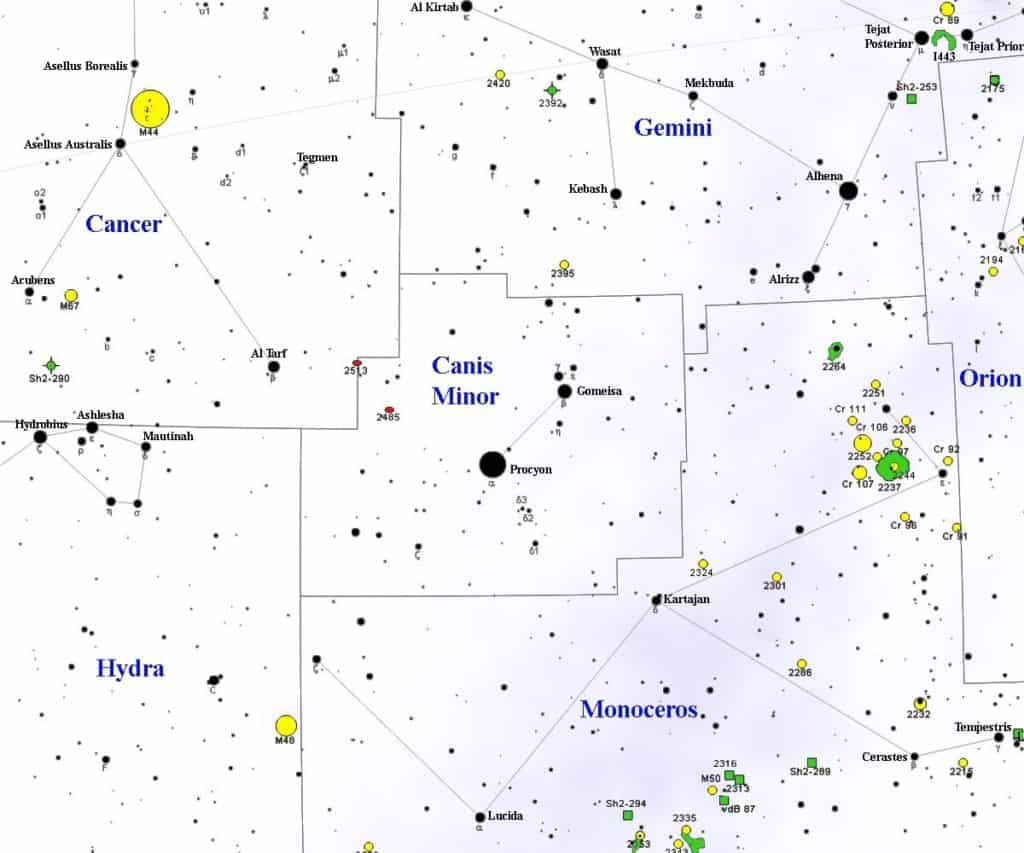
Procyon appears just to the left of Orion’s hourglass asterism, above Sirius. It forms the Winter Triangle with its bright neighbors Sirius and Betelgeuse.
It also marks one of the vertices of the larger Winter Hexagon. This Hexagon or Winter Circle - is formed by Procyon, Sirius, Pollux, Capella, Auriga, Aldebaran, and Rigel – some of them being in different constellations.
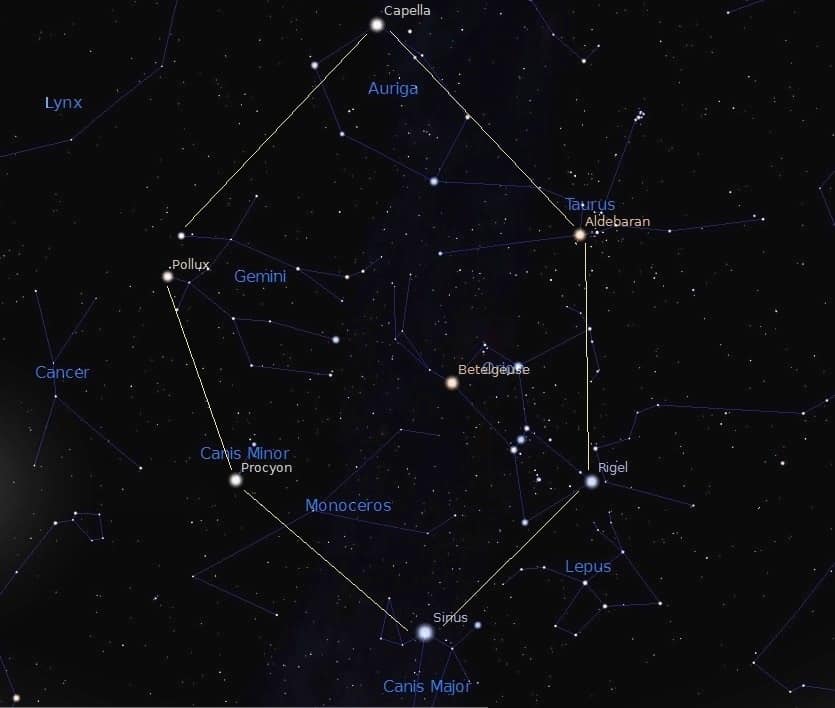
The Future
Based on its brightness, Procyon is too bright for its spectral class. This is an indicator that the star has almost run out of hydrogen in its core and has begun to expand as it continues to evolve into a subgiant.
Estimates suggest that Procyon will continue to expand until it is 80 to 150 times its current size and turn orange or red at some point in the next 10 to 100 million years. Thus, Procyon will end its life as a white dwarf, one not unlike Procyon B.
Did you know?
- Procyon is slightly fainter than Rigel and sometimes is it outshone by the variable supergiant Betelgeuse which is located in the same area of the sky, but much farther away from us than Procyon.
- Procyon has been given a special status – it is one of the 58 bright stars in the field of celestial navigation. Many of its neighbors are also in this class such as Sirius, Adhara, Betelgeuse, Rigel, Bellatrix, Alnilam, and Pollux.
- Procyon B’s existence was first inferred in the 19th century, based on irregularities in its motion.
- Procyon is often used in many works of fiction such as literature, films, television, and even video games such as Cabal Online.
- The ancient Chinese knew Procyon as the Third Star of South River. The South River was an asterism formed by Procyon, Gomeisa, and Epsilon Canis Minoris.
- One Arabic name for Procyon was Al Shira – meaning the Syrian sign.
- The flag of Brazil features 27 stars with each and every one of them symbolizing a Brazilian Federative Unit. Procyon is one of these stars and it represents the state of Amazonas.
- To the ancient Egyptians, Procyon represented Nangar, an aspect of the god Marduk known as the Carpenter. He rebuilt the heavens and organized the sky.
- In the Macedonian folklore, Sirius and Procyon were known as “the wolves” – Volci – circling around a plow with oxen, represented by the constellation of Orion.
Sources:
Image source:
- https://en.es-static.us/upl/2016/02/procyon.jpg
- https://cayelincastell.com/wp-content/uploads/2017/10/behenian-star-glyphs.jpg
- https://upload.wikimedia.org/wikipedia/commons/0/02/Procyon_A.png
- https://www.star-facts.com/wp-content/uploads/2019/09/Procyon-A-and-Procyon-B.jpg?189db0&189db0
- https://www.star-facts.com/wp-content/uploads/2019/09/Canis-Minor-constellation.jpg
- https://www.universetoday.com/wp-content/uploads/2008/10/Winter-Hexagon.jpg
